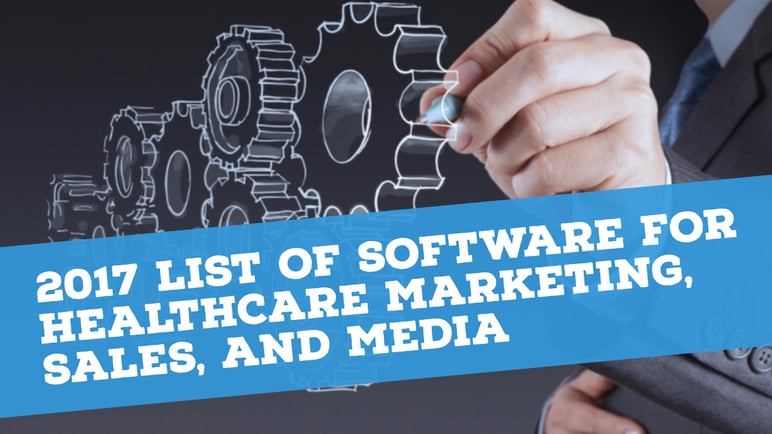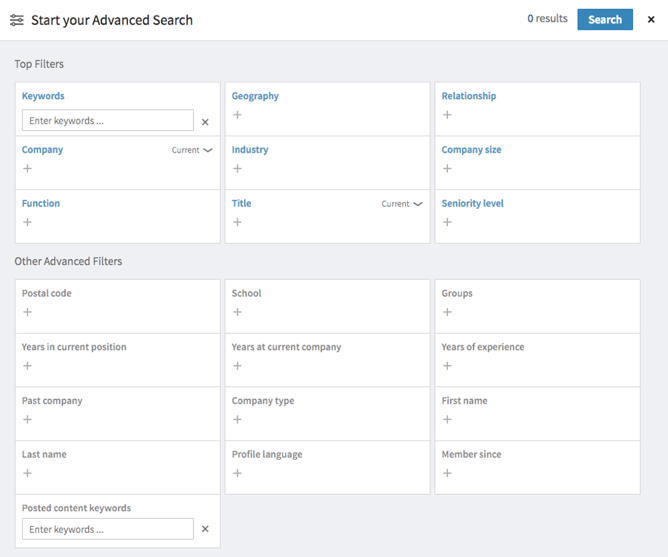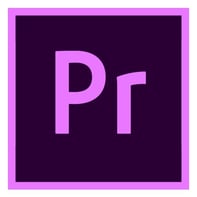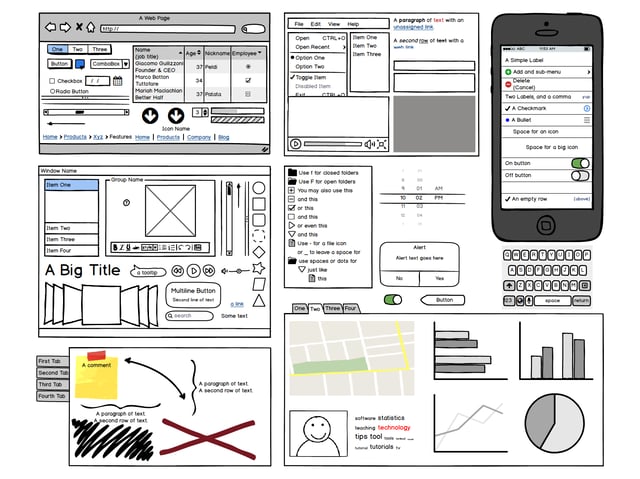As a digital healthcare marketing agency, we are faced with the challenge of trying to keep up with two industries (healthcare and marketing) that evolve at an incredibly fast pace. In order to keep up, we are constantly evaluating the tools that we use. Our founder Casey O'Quinn likes to say "having the right tool for the job makes all the difference in the world." This is true whether you're fixing a car or trying to execute a content strategy. We've gone through periods as a company where we "got by" with mediocre software, but we have become more effecient and effective by focusing on finding and using the right tools.

This is a long post. Feel free to use the links below if you'd like to skip to a specific section.
Tools for Marketing and Project Management
by Marketing Director Matt Brannon
Tools for Prospecting & Sales
by Founder and Principal Casey O'Quinn
Tools for Video Production and Post Production
by Matt Dufilho
Tools for Design
by Casey O'Quinn
Tools for Marketing and Project Management
by Matt Brannon
Hubspot
 This is the no-brainer. Hubspot is the Ferrari of marketing software. There are many different versions available and at Gravity Digital, we use the Pro version. We use it in some capacity for just about every day-to-day marketing activity for ourselves and for our clients.
This is the no-brainer. Hubspot is the Ferrari of marketing software. There are many different versions available and at Gravity Digital, we use the Pro version. We use it in some capacity for just about every day-to-day marketing activity for ourselves and for our clients.
The software is built to facilitate the Inbound Methodology which occurs in four phases:
To attract traffic, we use the blogging platform to write and optimize posts for search engines and we use the social media publishing and monitoring function to promote content. There is also an add-on for social ads, which we are likely going to switch to from our current solution.
To convert visitors into leads, we use Hubspot to create forms, landing pages, and calls-to-action that collect visitor info and feed it to the built-in CRM where contacts can be automatically segmented into as many lists as we can think of.
To close deals and delight customers, Hubspot has the capability to create intricate automated email workflows that we can use to nurture leads and send the right content to the right person at the right time. The marketing side obviously pairs very well with the Hubspot Sales tools which make everyone happier and more efficient. All efforts are tracked with built-in reporting tools so we can continue to improve and optimize.
And it has an app.
Jira by Atlassian
 We started using Jira for project management a few months ago. It came as part of a major shift in our structure to agile. Just as Hubspot is built to market using the Inbound Methodology, Jira is built around the agile project management methodology. If you aren’t familiar with the agile concept, it was born in the software development world. Basically, tasks are accumulated in a backlog and prioritized and then pulled into short “sprints” for agile teams to tackle issues, and then review and improve processes before the next sprint begins. We love the flexibility that agile offers. Marketing needs change rapidly, and so should tactics and marketing activities.
We started using Jira for project management a few months ago. It came as part of a major shift in our structure to agile. Just as Hubspot is built to market using the Inbound Methodology, Jira is built around the agile project management methodology. If you aren’t familiar with the agile concept, it was born in the software development world. Basically, tasks are accumulated in a backlog and prioritized and then pulled into short “sprints” for agile teams to tackle issues, and then review and improve processes before the next sprint begins. We love the flexibility that agile offers. Marketing needs change rapidly, and so should tactics and marketing activities.
Jira takes some getting used to. In fact, we had completely missed one of the major functions of the software until we happened to catch a glimpse of another agency’s dashboard during a webinar. Now that we’ve spent a bit more time getting familiar with all the boards and tools, however, we’ve found it to be very powerful and a perfect fit for agile project management.
And it has an app.
Moz Pro
 Admittedly, while we are raving fans of Hubspot, we have found the keyword research tools to be a bit underwhelming. Moz Pro, on the other hand, has been very insightful. The software offers actionable SEO suggestions, competitor analysis that includes individual keywords, backlink research, rank tracking, and a lot of other stuff that’s way over my head. If you’ve seen some of my other posts you know that SEO tactics irk me at times, but I actually enjoy researching on Moz and spending time on Rand Fishkin’s Whiteboard Fridays.
Admittedly, while we are raving fans of Hubspot, we have found the keyword research tools to be a bit underwhelming. Moz Pro, on the other hand, has been very insightful. The software offers actionable SEO suggestions, competitor analysis that includes individual keywords, backlink research, rank tracking, and a lot of other stuff that’s way over my head. If you’ve seen some of my other posts you know that SEO tactics irk me at times, but I actually enjoy researching on Moz and spending time on Rand Fishkin’s Whiteboard Fridays.
Slack
 Flashback to last year when we were on a flight to a conference that was full of other marketers and agency types. I got up at one point and chuckled as I walked down the aisle and noticed that 90% of the plane was typing away on their laptops, but then I noticed something that alarmed me. They all had the same app running… and I had no idea what it was. It was Slack. I spent the rest of the flight peeking over seats trying to figure out what I’d been missing. Yes, we are very late to the Slack bandwagon. Minus 2 cool points.
Flashback to last year when we were on a flight to a conference that was full of other marketers and agency types. I got up at one point and chuckled as I walked down the aisle and noticed that 90% of the plane was typing away on their laptops, but then I noticed something that alarmed me. They all had the same app running… and I had no idea what it was. It was Slack. I spent the rest of the flight peeking over seats trying to figure out what I’d been missing. Yes, we are very late to the Slack bandwagon. Minus 2 cool points.
Slack is simply a very robust, but straightforward, communication tool. Imagine if Instant Messenger and Skype had a baby and it became the most popular kid in school. It has integrations with dropbox and other tools so file sharing is easy. You can create different channels for different teams or topics. You’ll notice, however, that most communication on Slack will quickly turn from business to a stream of funny gifs and emojis.
One of my favorite features is a Hubspot integration called Growthbot. Growthbot is still somewhat young, but it can already do some pretty cool things… it can give you data on competitors like website traffic and ad spends… and it can give you personality profiles and tips for communicating with contacts. They are eerily accurate. Here’s an example of mine:
Personality profile for Matt Brannon:
This person is a decisive, creative influencer: Forward-thinking, ambitious, and spontaneous with a natural aversion to rigid structure.
Advice for communicating with them:
-
Bring lots of energy to the conversation
-
Speak with an informal tone
-
Use self-deprecating humor (don't act like you take yourself too seriously)
-
Interrupt them if the conversation is going too long
-
Use visual aids
I do love visual aids… and yes, Slack is an app.
Tools for PROSPECTING & Sales
by Casey O'Quinn
Background
As the defacto salesperson at Gravity Digital, I’ve had to work hard at sales. Sales does not come naturally for me. In fact, I find it kind of “icky”. However, as we transitioned into healthcare marketing, I knew we would need a solid plan to grow insde the niche. I overcome this a couple of ways:
- I have a “help first” mentality. I want the sale to be the furthest thing from my mind when I reach out to a prospect. I want to answer their questions and do my best to point them in the right direction.
- I work from an Ideal Company Profile to identity businesses that are the BEST fit for our services. We have about 5 criteria that a business must meet to fit our Ideal Company Profile. If I’m reaching out and have no previous relationship, they need to be a lock for our services.
- I also work from Buyer Personas. Within that company, I’m looking for a couple of very specific individuals. If I can locate one of those, I have a good feel for the specific challenges and goals someone in that position faces on a regular basis. Most importantly, I know I can help (there’s that word again) that person.
With that as our foundation, here are the tools I use for sales activities:
Prospecting: LinkedIn Sales Solutions
 Referrals are gold. They usually come from a current or previous client, and there is immediate trust… things are simply ‘easier’ with referrals. But there are great opportunities out there. Businesses that need our help. Businesses that we’re confident we could help see real results. To help me identify companies and individuals, I like LinkedIn Sales Solutions.
Referrals are gold. They usually come from a current or previous client, and there is immediate trust… things are simply ‘easier’ with referrals. But there are great opportunities out there. Businesses that need our help. Businesses that we’re confident we could help see real results. To help me identify companies and individuals, I like LinkedIn Sales Solutions.
There are a host of features within the product, but my “go to” is definitely Sales Navigator. Because we work from an Ideal Company Profile and Buyer Personas, I have a very clear idea of who I am looking for. I need to maintain a narrow focus to protect my time and make sure I’m reaching out to “best fit” prospects.
The Lead Builder feature includes an Advanced Search tool that allows me to dive very deep in my quest for those “best fit” companies and individuals. Here’s a screenshot of the Advanced Search tool:

The filters are closely aligned with our Ideal Company Profile and Buyer Persona attributes. After getting the results of the advanced search, I move on to the research phase to better qualify prospects.
Research: LinkedIn, Company Website, Google & JOB BOARDS
After finding prospects, I like to research the companies and individuals to further qualify them for our services and overall fit.
1. LinkedIn
I always view the prospect’s LinkedIn profile, and I make sure to check out these specific areas:
- Title/Position: Am I sure this is the right person at the company I should be pursuing?
- Location: We’re not geographically limited, but many businesses are. It’s good to know if you can service the business based on their location. I also look for their location to see if I’ve ever travelled to their city – perhaps something I can use to connect.
- Experience: This is great for getting a feel for how long they’ve been with the company, how long they’ve been in the industry and what kinds of challenges they might face.
- Education: I like to know if they have a degree in the industry in which they work. Looking at the college they attended may give me a chance to connect about schools, conferences, sports, etc.
- Connections: This is important. Do we have any common connections? If so, is it a connection that might be able to get me an introduction?
- Groups: I always look to see if we are members of the same groups. If so, I dig in to see if they are active in the group, perhaps posting content or commenting. It’s possible I will circle back and engage on LinkedIn if and when it’s appropriate.
- Content: If the prospect posts original content or shares company and industry info through LinkedIn, I read it.
2. Company Website
No brainer, right? Visit the website, read about their company, products, services, etc. Also be sure to read the company blog and read any downloadable resources like eBooks and case studies. If they have an upcoming webinar, I might tune in to learn more about the company and my prospect.
3. Google
 Google can be a great way to find what others have to say about the company/prospect you are researching. Look for News, Press Releases, and Financial Reports. These can be telling, and may lead you to information that a company has not included on their website for any number of reasons.
Google can be a great way to find what others have to say about the company/prospect you are researching. Look for News, Press Releases, and Financial Reports. These can be telling, and may lead you to information that a company has not included on their website for any number of reasons.
4. Job Boards
 A quick look on Monster or Indeed can give you a good idea if the company is growing and what kind of needs they might have. If your product addresses one of their hiring needs, this can be a great way to find a “best fit” company.
A quick look on Monster or Indeed can give you a good idea if the company is growing and what kind of needs they might have. If your product addresses one of their hiring needs, this can be a great way to find a “best fit” company.
Communication
After my research has led me to a prospect that matches one of our Buyer Personas, and their company fits our Ideal Company Profile, it’s time to reach out. But where do you start, and how do you manage it?
1. Phone Number
The phone number is usually listed on their website, and many companies have a dial by name directory. It can sometime be tough getting past the gatekeeper, but that’s a post for another day.
2. Hunter and Mail Tester
 Sometimes I may want to reach out by email. Some companies have a nice team section with bios and your prospect’s email address is hand-delivered to you. Usually, it’s going to take some work do find it. I use two products to help with this:
Sometimes I may want to reach out by email. Some companies have a nice team section with bios and your prospect’s email address is hand-delivered to you. Usually, it’s going to take some work do find it. I use two products to help with this:
- Hunter – There are free and paid versions of this service. It helps you do some very hard things like discover the email format a company uses, and also find and verify email addresses.
- Mail Tester – If you are open to guessing or perhaps already know the format of the email address, Mail Tester is a free way to discover your prospect’s email address.
3. HubSpot CRM
Once I have the prospect’s name, company, phone number, email address, title and other important information, I load it into HubSpot’s CRM. We use the full stack available from HubSpot: CRM, Marketing Automation, and Sales Professional.

Without the CRM, I would be lost. With a couple of clicks, I can see everything I need to know about a contact, see my previous emails, and read any notes I’ve made. For more on CRM’s check out my article on 3 Signs You Need a Healthcare CRM.
4. HubSpot Sales Pro
 Any of the HubSpot plans include a basic (but good) version of their Sales tools. If you are looking for something really powerful, you need to look at upgrading to Sales Pro. Here are some of my favorite features – I use them daily.
Any of the HubSpot plans include a basic (but good) version of their Sales tools. If you are looking for something really powerful, you need to look at upgrading to Sales Pro. Here are some of my favorite features – I use them daily.
- Meetings – With Meetings, I can send a prospect a direct link to my calendar and put them in the driver’s seat on booking a call or meeting with me. No back and forth emails trying to find a time that will work. I also make sure to include the link in my email signature, and as part of our marketing automation and workflows.
- Sequences – This feature of Sale Pro saves time and makes sure no follow up activities slip through the cracks. I’ve taken our most effective sales activities and placed them into a repetitive process. Personalized emails are sent automatically, and reminder to engage with a prospect on social media, or place a phone call are created automatically.
- Email Open and Click Notifications – I like to strike while the iron is hot, and know when a prospect has downloaded a resource or blog post I sent. Whether you want to call when they are reading your email, or simply know that they’ve read it, it’s a very powerful way to get more out of email.
- Prospects – Pursuing sales leads can take time. Prospects is a tool that tracks their visits to our site. This allows me to determine which prospects are warm and engaged with our site and content. I also get revisit notifications that give me a heads up when a prospect has come back to our site, allowing me to focus sales efforts on those that are most likely to close.
Tools for Video Production and Post Production
by Matt Dufilho
Gear
I’m going to speak generally here because there are just so many options when it comes to gear. The important thing is that you have a solution in place and consider each of camera, lighting, and audio:
For the camera, the primary consideration is that you are using something digital. Please don’t use anything that still uses a tape - I believe it’s morally wrong at this point. The price range on cameras is so vast: starting from your phone, which probably has a pretty decent camera, all the way up to studio-type cameras that cost tens of thousands of dollars. A solid DSLR is the standard for most corporate type video, but use the best available.
It’s great to have a set of lights, but you can often find production scenarios where you can use the light available. Just be aware of placement. Give the subject nice, even light and avoid harsh shadows. Always be aware of any natural light available.
Audio is possibly the most important and often the most overlooked of the three. I always say that you’d rather have a bad looking video with good audio than the other way around. Don’t count on your camera’s built-in microphone. Zoom makes good recorders that are $100 or less, pair them with a lapel mic and you’re in good shape. If you have a bigger budget and an extra set of hands (or a stand), go for a larger mic that hangs in from above.
If you are going to have video as part of your strategy long term and you need buy equipment, I’d recommend looking at bhphotovideo.com. In my 20+ years of experience, I’ve yet to find anyone who can beat their prices or service. If you’re just looking at doing a few projects or test the waters, lensprotogo.com is good for rentals (or look for a local option).
Education
Video production has become so democratized and there are so many great resources out there for learning. YouTube is a great start for just about anything you want to learn. If you have a specific technical question about video, chances are the answer can be found on YouTube. I’m also a huge fan of Lynda.com. The site has some outstanding courses over a large variety of topics, including video. In fact, I’ve been to some major conferences and found that they were teaching Lynda courses. It’s only about $25.
Adobe Premiere
 I am a “Final Cut refugee” and I now work exclusively with Adobe products, but it is by no means the only good option out there. Much like gear, you can use what’s available. Any non-linear editor (NLE) can get the job done. Again, there is a wide price range. Free options are likely built into your computer’s software, MovieMaker or iMovie. Sony Vegas and Final Cut 10 are still good options, and then at the very high end are Avid systems.
I am a “Final Cut refugee” and I now work exclusively with Adobe products, but it is by no means the only good option out there. Much like gear, you can use what’s available. Any non-linear editor (NLE) can get the job done. Again, there is a wide price range. Free options are likely built into your computer’s software, MovieMaker or iMovie. Sony Vegas and Final Cut 10 are still good options, and then at the very high end are Avid systems.
Wipster
 Wipster is a tool that I like to use to share rough cuts with stakeholders and other creatives on the team. It allows reviewers to provide their feedback by simply pointing and clicking as they watch the video. It also integrates with Adobe Premier and Slack. Just a word of warning, only send early cuts to very trusted reviewers who understand the post-production process.
Wipster is a tool that I like to use to share rough cuts with stakeholders and other creatives on the team. It allows reviewers to provide their feedback by simply pointing and clicking as they watch the video. It also integrates with Adobe Premier and Slack. Just a word of warning, only send early cuts to very trusted reviewers who understand the post-production process.
TOOLS FOR DESIGN
by Casey O'Quinn
While I have generally stepped away from most of my design duties, I was an active designer here at Gravity Digital in the early days. I’m still involved in the creative process for most projects, and fire up most of these programs on a regular basis.
Here are the tools and software we use when designing websites, eBooks, graphics and anything else that needs a creative touch.
Photoshop
Photoshop is my “go to” program for photo editing, photo manipulating, and general graphics work. I’ve been using it for over 15 years, and I’m comfortable in it. I once heard someone say, “if you know how to use Photoshop, you’ll never go hungry”. I don’t know if that’s quite true, but it’s a program that takes some time to learn but pays big dividends. Here are a few ways we use it:
- Photo Editing: General edits like cropping, resizing, colors/saturation, etc. Also, “saving for web” to get the best quality and smallest file size.
- Photo Manipulation: Removing objects, painting out a logo on a shirt, covering distracting parts of a photo. Very handy when the stock photo you’ve licensed is great, but not perfect.
- Graphics: When I need “whip up” a quick graphic like a Call to Action or Facebook image and I’m confident I don’t need a vector version, I’ll use Photoshop.
- Websites: We design website interfaces in Photoshop. This allows us to work quickly to get make revisions and get design approved by clients before we write one line of code.
Adobe Illustrator
 While Photoshop is great for “raster” work, we use Illustrator for important graphics that we know will need to scale and be used in a variety of ways like signage, screen printing, embroidery, etc. Most every company doing this kind of work will request a vector file.
While Photoshop is great for “raster” work, we use Illustrator for important graphics that we know will need to scale and be used in a variety of ways like signage, screen printing, embroidery, etc. Most every company doing this kind of work will request a vector file.
Illustrator, and other vector programs, can be frustrating for those coming from a program like Photoshop. However, if you are creating a logo or graphic that is important, it really needs to be created in a vector program free of the pixels that can limit raster-based images.
Adobe InDesign
InDesign is Adobe’s product for page layout. We use InDesign to create eBooks, brochures, case studies, etc. Think of InDeisgn when you need to create a text-heavy, multi-page piece.
It’s simple to save PDF’s for digital downloads for our clients’ websites, and it’s become a standard for the printing industry and we have everything we need to output files based on each of our client’s preferred printing companies.
Adobe Spark
 What did we do before Adobe Spark? We spent way too much time designing social media graphics, cover images, and featured post images for blogs.
What did we do before Adobe Spark? We spent way too much time designing social media graphics, cover images, and featured post images for blogs.
Spark is a web-based graphic design app, that is very easy to use – even for non-designers. Quickly design an image and output all of the sizes needed for Facebook, Instagram, Twitter and blogs.
Balsamiq Mockups
I referenced using Photoshop for designing website interfaces, but before we move into that design phase we start with wireframes. A wireframe is a simple black and white sketch of a website or application interface. It’s a great place to start to make sure you’ve focused on usability and elements of UX (user experience) before looking at colors, photos, copy, etc.

Balsamiq is a quick and easy way to create these wireframes and has pre-built elements for just about application.
There you have it! As I said at the top of the post, we are constantly evaluating and looking for new tools and software that works for healthcare marketing. If you have any recommendations, please let us know in the comments!
 About the Author
Matt Brannon
About the Author
Matt Brannon
Matt graduated from Baylor University in 2003 and married his college sweetheart Ginny. They moved to Austin and Matt began working for Governor Rick Perry, first as an Advance Man and then later as the Governor’s Executive Aide. In 2007, Matt and Ginny moved to Los Angeles where Matt worked in public relations for an independent film (and Toronto Film Fest winner), “Bella”. His primary role was implementing grassroots efforts on a new online network called “Facebook”. After the promotion of Bella came to an end, Matt worked various jobs in entertainment and also spent 5 years working at Cedars-Sinai hospital. in 2013, Matt and Ginny moved back to their home state of Texas and joined the team at Gravity Digital. Matt’s distinctive value for his clients is his ability to bring out-of-the-box ideas and solve problems creatively.
Follow Matt Brannon:
LinkedIn |
Twitter


